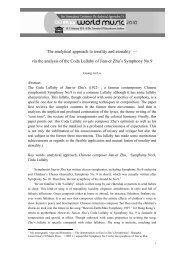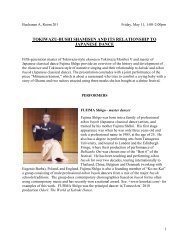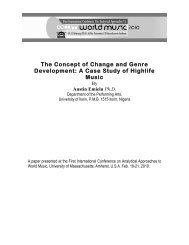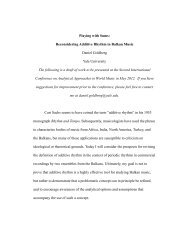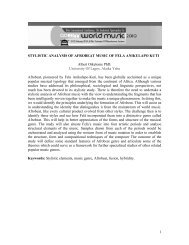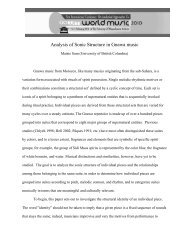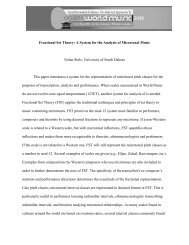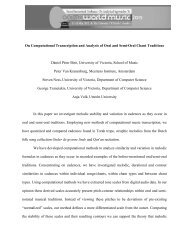You also want an ePaper? Increase the reach of your titles
YUMPU automatically turns print PDFs into web optimized ePapers that Google loves.
Old Auditorium Friday, May 11, 8:00 pm<br />
GAMELAN GITA ASMARA<br />
Wayan Sudirana, Music Director<br />
Putu Widiantini, Dance Director<br />
Michael Tenzer, General Director<br />
Dewa Made Supartha, special guest musician<br />
Keiko Ninomiya, special guest dancer<br />
1
PROGRAM<br />
Sekar Gendot<br />
This crystalline music by the renowned composer I Wayan Lotring, active in the 1920s and '30s,<br />
was arranged from a composition used to accompany the shadow play theatre. It features quick<br />
melodies divided among the players into interlocking parts, played in counterpoint with a slowermoving<br />
melody in the bass.<br />
Baris<br />
Baris means row, rank, or file, and is a traditional dance of a warrior in preparation for battle.<br />
The dancer cues the gamelan through a series of unpredictable accents called angsel, reflecting<br />
his watchful state. With Kadek Hari Candana.<br />
Tabuh Pisan Bhaskara (I Wayan Sudirana 2012)<br />
Sudirana’s new composition tests his mettle as a Balinese master by taking on the most sacred<br />
and prestigious genre of temple ritual music, called lelambatan. Classic lelambatan are<br />
performed in a bare-bones style at religious rituals and meant for the Gods to hear. Sudirana<br />
began from one such bony melody, borrowed from the repertoire of the gamelan of the imposing,<br />
ancient mountain temple of Batur. He then stretched, layered, developed and expanded it into the<br />
Balinese equivalent of a Brahms symphony.<br />
The music's "family name"—the standard form it uses—is identified by the title words<br />
Tabuh Pisan, which mean "one stroke" and refer to the sole stroke of the kempli (a small gong)<br />
between large gong strokes in the music’s central section. Bhaskara is the "given name"; it<br />
means glittering or bright. The composer writes:<br />
"Composing and playing music involve life, and it revolves around you.<br />
Search for your identity through the art of patience, and explore the<br />
meaning of art given by your ancestors. Don't be scared to create<br />
something new from something that was endowed to you! Keep it up,<br />
onward and upward!"<br />
INTERMISSION<br />
Legong Kuntul<br />
The Legong dance genre supposedly originated in the divine visions of a meditating prince in the<br />
village of Ketewel, south Bali. It developed many variants and styles during the 20 th century and<br />
became known as the island’s quintessential refined female dance style. The version we present,<br />
Kuntul, depicts four herons in the rice fields. There is no story and most of the movements are<br />
abstract, but in some of the later sections of the dance the birds’ graceful gestures can be<br />
discerned. With Meris Goodman, June Lam, Keiko Ninomiya, and Ni Putu Suci Prawesti.<br />
Wiran Jaya<br />
Wiran Jaya was developed in the late 1930s in North Bali as part of the new and<br />
fiery kebyar style of music and dance, which spread like wildfire all over Bali and became<br />
famous around the world. The moods, energy and playfulness of youth are the central inspiration<br />
for the dance, while the music reflects this with virtuosity, speed, and drive. The title means<br />
“Victorious Hero.” With Putu Widiantini.<br />
2
PERFORMERS<br />
GGA MUSICIANS: Jack Adams, Jonathan Adams, Rodrigo Caballero, Mathew Davidson,<br />
Joseph Glaser, Meris Goodman, Robyn Jacob, Madé Kartawan, John Kastelic, June Lam,<br />
Charlene Morris, Paul Patko, Emily Rogers, Innessa Roosen, Shawn Sekiya, Jordan Soet, Wayan<br />
Sudirana, Michael Tenzer, Leslie Tilley, Kris Victory, Putu Widiantini.<br />
GGA DANCERS: Meris Goodman, June Lam, Ni Putu Suci Prawesti, Putu Widiantini, Kadek<br />
Hari Candana<br />
GAMELAN GITA ASMARA was founded as a student ensemble in1996 by Michael Tenzer.<br />
In 2005 a core group of players split from the class group, and in 2006 <strong>Gamelan</strong> <strong>Gita</strong> <strong>Asmara</strong><br />
became a Registered Non-Profit Society. Using a new kind of Balinese gamelan set called<br />
Semaradhana, the group learns Balinese repertoire on an intensive practice schedule. Members<br />
bring long-term focus and commitment to rehearsal and performance. Over the years, <strong>Gita</strong><br />
<strong>Asmara</strong> has commissioned several new works from its first guest artistic director Dewa Ketut<br />
Alit (in residence 2001-04), its current director I Wayan Sudirana, and composers Colin<br />
MacDonald and Jocelyn Morlock. <strong>Gita</strong> <strong>Asmara</strong> is a dedicated collective committed to mastering<br />
this challenging music together, the rewards of making something of aesthetic and social value,<br />
and the joy of sharing this with their audiences.<br />
I Wayan Sudirana was born in Ubud, Bali in 1980. He is a graduate of the ISI Balinese Arts<br />
Institute and a member of the Çudamani collective. He is one of Bali’s most gifted young<br />
musicians, has composed and taught actively all over the island, and toured abroad frequently.<br />
He has been visiting artist-in residence at UBC since 2004 and is completing a PhD in Music at<br />
UBC.<br />
Ni Putu Widiantini was born in Nusa Penida, Bali, and graduated from ISI Academy. She is<br />
widely known for her dynamic portrayals of Balinese female dances.<br />
I Dewa Madé Suparta is from a musical family in Pengosekan, Bali, and was a founding<br />
member of the Çudamani gamelan collective with whom he toured abroad many times. He is<br />
director of <strong>Gamelan</strong> Giri Kedaton in Montreal, and teaches gamelan at Université de Montreal.<br />
Keiko Ninomiya is the founder of the Yuragi Dance Project and co-founder of AKA Dance,<br />
ZUKE and Green Tea, which is a collective of Japanese contemporary dancers in Toronto. She is<br />
currently studying and teaching traditional Balinese dance from court repertoire to contemporary<br />
compositions.<br />
Ni Putu Suci Pramesti (age 14) and I Kadek Hari Candana (age 10) have just come to Canada<br />
from Bali to join their father Madé Kartawan, who is studying at UBC. They have both learned<br />
dance since age 3, and Kadek Candana recently won the prize for best child Baris dancer in Bali.<br />
Michael Tenzer is Professor of Music at UBC, a composer, and author of scholarship on<br />
Balinese music and other topics.<br />
3



